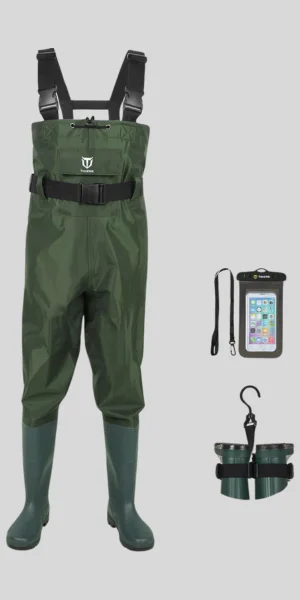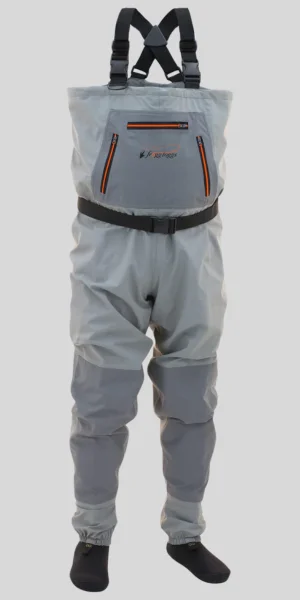When it comes to choosing the right waders for your outdoor adventures, one of the biggest decisions you’ll have to make is between boot foot and stocking foot waders. Both options offer their own set of advantages and disadvantages, making it important to understand the differences before making a purchase.
In this guide, we will explore the key features of each type of wader and help you determine which is the best choice for your needs. Whether you’re a seasoned angler or new to outdoor activities, this information will help you make an informed decision when it comes to boot foot vs stocking foot waders.
Key Difference Between Boot foot Vs Stocking foot Waders:

Stockingfoot Wader

Bootfoot Waders
Material:
One of the most important factors to consider when purchasing waders is the material. Boot foot waders are typically made from neoprene, rubber-coated nylon, or Gore-Tex fabric. These materials are very durable and long lasting, making them ideal for outdoor activities like fishing and hunting.
Stocking foot waders, on the other hand, may be made from any type of waterproof material such as nylon or polyester with a water resistant coating. This makes them lighter and more comfortable than bootfoot models but they won’t be as durable over time.
Comfortability:
Another key factor to consider between boot foot and stocking foot waders is comfort. Bootfoot models are usually more comfortable when worn for extended periods of time, as the entire foot is encased in neoprene or other waterproof material.
Stocking foot waders typically have a separate ankle gusset and upper body section which can cause them to rub against the wearer’s skin and become uncomfortable after prolonged use. Stocking foot waders require some additional setup such as attaching boots or wading socks before they can be used which adds to the overall discomfort.
Versatility:
Bootfoot models are incredibly versatile and can be used for a variety of activities such as fishing, hunting, or simply walking in the rain. Stocking foot waders are also quite versatile but require more setup time and preparation before they can be worn. They’re best suited for anglers who need to move quickly from one spot to another or those who want additional protection from water and debris when walking through streams or rivers.
Durability:
Bootfoot models are generally more durable than stocking foot waders, as they’re made from thicker materials such as neoprene or rubber-coated nylon. Stocking foot waders may be less durable due to the thinner materials used, but they can last for many years if properly cared for and stored correctly.
Breathability:
Bootfoot models are typically more breathable than stocking foot waders, as the materials used are designed to be lightweight and allow air to pass through. Stocking foot waders may have some breathability depending on the material used, but it’s usually less than what bootfoot models offer. This makes them more suitable for warmer climates or activities that require a lot of physical exertion.
Storage Features:
Bootfoot models usually come with some type of storage feature such as a pocket or pouch for storing small items like lures or hooks. Stocking foot waders may not have any storage features, but anglers can easily add their own using accessories like lanyards, zingers, and carabiners.
Waterproofing:
Both bootfoot and stocking foot waders are designed to offer waterproof protection, but they may offer different levels of waterproofing depending on the materials used. Bootfoot models are usually more effective at keeping water out due to the thick neoprene material, while stocking foot waders may require additional waterproofing for complete protection.
Affordability:
Bootfoot models are typically more affordable than stocking foot waders due to the simpler design and construction. Stocking foot waders can be pricier because they require boots or other accessories that add to the overall cost. Some of the higher end materials used on stocking foot models can increase the cost even further.
Related Posts: Neoprene Vs Breathable Waders , Fishing Waders Vs Hunting Waders
Bootfoot Waders Review:
Boot foot waders are a great option for anglers who want durability and protection without sacrificing comfort. They’re usually more comfortable to wear, breathable, and include pockets or pouches for storage.
Bootfoot models can also be used in a variety of activities such as fishing, hunting, or simply walking in the rain. However, they may not offer the same level of waterproofing as stocking foot waders and can be more expensive due to the thicker materials used.
Stockingfoot waders Review:
Stocking foot waders are a great choice for anglers looking to stay lightweight and agile on the river or lake. These neoprene waders provide a snug fit that offers comfort, waterproofing, and breathability all in one package.
The stocking foot design allows you to customize your boot size and type for ultimate support, no matter what kind of terrain you’re navigating. With adjustable suspenders and waistbands, it’s easy to find a comfortable fit as well.
Similarities Between Bootfoot Or Stockingfoot:
- Both protect you from the water
- Both can be expensive
- Both require some care and maintenance
Both protect you from the water:
Waders are designed to keep you dry and warm while you’re out fishing in cold or wet conditions. No matter which type of wader you choose, you can rest assured that it will do its job in keeping you dry and comfortable.
Both can be expensive:
Waders are a significant investment, so you’ll want to make sure that you choose a pair that’s right for your needs. No matter which type of wader you decide on, be prepared to spend a good amount of money to get a quality pair that will last you for many fishing seasons.
Both require some care and maintenance:
Waders are not indestructible, so it’s important to take good care of them. Make sure to follow the manufacturer’s instructions for cleaning and storing your waders, and inspect them for any tears or leaks before each use. By taking good care of your waders, you can extend their lifespan and enjoy many years of comfortable fishing.
Conclusion:
Both bootfoot and stocking foot waders are excellent options for anglers who want to stay dry and comfortable while fishing. Boot foot models offer more durability and storage features, but may not be as waterproof compared to stocking foot models.
Stocking foot waders are lightweight and easier to move around in, but require additional setup time before they can be worn. The choice comes down to your own personal preferences and needs.
FAQs:
Are stockingfoot waders better?
The answer to this question depends on what you are looking for in a pair of waders. Stockingfoot waders provide certain advantages over bootfoot waders, such as being lightweight and more packable, and having better breathability and insulation.
Bootfoot waders offer superior protection from cold weather conditions, as they are designed with integrated boots that keep your feet warm and dry even in chilly waters.
What is the point of stockingfoot waders?
Stockingfoot waders are an essential piece of outdoor gear for anglers, hunters and other outdoor enthusiasts. These garments provide the necessary protection from cold water and wet conditions while allowing mobility and flexibility.
A stockingfoot wader consists of a waterproof outer shell, insulation layer and a breathable inner liner that supports your foot in the right way when walking through wet areas. The main benefit of this kind of wader is that it allows you to stay warm, dry and comfortable while actively fishing or hunting in cold, damp conditions.
Do your feet get wet in stockingfoot waders?
No, your feet should not get wet when wearing stockingfoot waders. The purpose of stocking foot waders is to keep water and other elements from entering the boot and causing discomfort or damage to your foot.
Stockingfoot waders are designed with an internal waterproof membrane that blocks moisture from seeping through the fabric, and sealed seams further ensure complete waterproof protection.
How do you wear Bootfoot waders?
Bootfoot waders are designed to be worn over your feet and up to the waist, making them a great choice for anglers who want protection from cold water or wet conditions. To properly wear this style of wader, start by putting on the stockingfoot part of your wader first.
This will provide extra insulation against the cold temperatures of the water. Then, slide your foot into the boot portion of the wader and pull it up until it is comfortably fitted around your foot and ankle.
